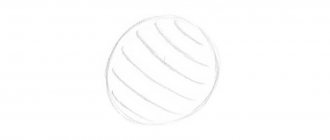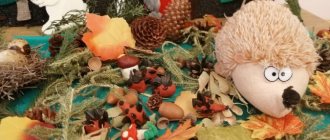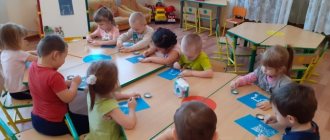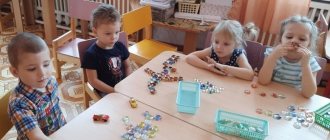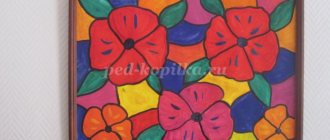Notes on non-traditional drawing "On a mushroom meadow" in the junior group
Lyudmila Pasikova
Notes on non-traditional drawing "On a mushroom meadow" in the junior group
Drawing foam rubber printing using a stencil
"In the mushroom meadow "
Program content: Teach children to depict mushrooms using a stencil using the “printing”
foam stick.
Practice drawing vertical short straight lines with your finger from top to bottom to depict grass. Develop a sense of color and rhythm. Cultivate curiosity and interest in drawing .
Materials, tools, equipment: illustration depicting mushrooms , stencils of mushrooms , sample teacher, foam sticks, sheets of A-4 paper, gouache, napkins.
The teacher shows an illustration of mushrooms and reads a poem:
We'll go into the woods, we 'll find a fungus ,
Small, okay, in a smart hat. (O. Vysotskaya)
Don't hide, mushroom in the grass ,
I'll rip you off anyway!
Examines parts of the mushroom , specifies color and size.
Then he turns his attention to the sheets of stencils. “You have mushrooms living in your clearing . But where are they? They hide behind the windows. Let's find them together? I dip the stick into the white paint and tap it on the “window”
.
Like this. Knock-Knock! Try it yourself.” Children accompany their movements with the words: “Knock-knock-knock
.
The teacher helps fill out the entire lower part of the window. mushrooms lack ? Now let’s fill the upper part of the “window”
. At the end of the work, the stencils are removed. The teacher reads a poem:
Look, mushrooms have appeared !
Brown cap, solid belly
You see, this is dad, it’s easy to recognize him.
We tried our best and found mushrooms in a green meadow .
GCD in the 2nd junior group “Mushrooms for the squirrel”
Summary of direct educational activities in the 2nd junior group
Topic: “Mushrooms for squirrels”
Integration of educational areas:
“Cognitive development”, “Speech development”, “Physical development”, “Artistic development”.
Target:
expand children's understanding of natural objects; develop creative abilities.
Tasks:
Educational: expand ideas about natural objects;
show in an accessible form the dependence of the life of flora and fauna on environmental conditions;
promote the memorization of small works of art, reproduce them;
the ability to determine quantity, compare objects by size “large”, “small”.
Develop the ability to use glue, a brush, and a napkin.
Developmental: consolidate jumping on two legs, walking on a gymnastic bench; enrich and activate children's vocabulary with nouns; develop sensory analyzers (auditory, visual, tactile); practice rhythmic and clear pronunciation of words, sounds [s], [w]; develop fine motor skills of hands and fingers;
Educational: to cultivate the need and willingness to show elements of creativity in different types of activities;
love for nature and respect for it;
Preliminary work
:
watching a squirrel, trees while walking, talking about the forest and its inhabitants, about beneficial and poisonous mushrooms;
looking at illustrations of mushrooms and drawing them. Methods and techniques:
visual, playful, verbal, practical, questions for children.
Equipment and materials:
large and small baskets, cones, nuts, acorns according to the number of children; decoration: easel, screen, squirrel, walnut trees, fir tree, oak; gymnastics board, 3 bumps, mushroom parts made from leaves, brushes, glue, napkins.
Move
— Guys, what time of year is it now? (autumn)
Let's go with you to the autumn forest, take baskets with us, we will probably need them.
Stand behind each other, let's hit the road (read the rhyme)
Let's walk happily together
Past the oak tree, past the Christmas tree,
Right along the path
And in our hands we hold wicker baskets.
You and I have walked along the path, and now we must jump from hummock to hummock, walk along the path a little more, and cross the bridge. So we came to a forest clearing. Look around.
— What trees grow in our forest? (Christmas trees, oak) Well done. Let's play in this clearing.
Psycho-gymnastics “Trees”.
They spun and spun and turned into trees. A light breeze blew, the trees swayed and made a shushing noise. Then a strong wind rose and the trees swayed more loudly. (Children raise their hands up and sway, saying shhhh quietly, loudly, quietly, the wind gradually died down). They spun and spun and turned into children.
The wind was so strong, it shook the trees so much that now there were a lot of cones and nuts on the ground. Tell me, from which trees did they fall? I'll start a sentence, and you finish it.
Cones grew on... (fir tree, pine tree)
Nuts grew on...(nut)
Acorns grew on ... (oak tree)
Well done. Guys, what animals live in the forest? (hare, bear, fox, wolf, boar). Guess the riddle about this animal.
Small, red.
In the forest he jumps along the branches,
Does he hide nuts in a hollow?
That's right, let's call the squirrel.
-su-su-su, su-su-su a squirrel was seen in the forest (they pronounce the phrase in a whisper, then loudly, and then quietly.)
Squirrel
: who called me here? Oh, is that you guys? Hello!
Children greet the squirrel.
Educator:
squirrel, why are you so sad?
Squirrel: How can I not be sad! My mischievous little squirrels have mixed up all my supplies for the winter, and I like everything to be in its place, and I haven’t even had time to collect mushrooms yet.
Educator:
guys, let's help the squirrel? (Yes).
Let's help you collect the cones first. Take one cone each.
Finger gymnastics.
I hold the cone in my hand,
I hold it in my fist,
I let go, I squeeze and I roll with my palm.
-How many cones do you have in your hand? And how many cones are in your hand... (Ask several people?)
- Now bring them to me in a large basket.
— How many cones are there in the big basket? (a lot of)
- Guys, now collect the nuts. Take one nut at a time and put it in my small basket.
- How many nuts are there in a small basket? (a lot)
- How many nuts are there in the squirrel’s paws? (one)
Squirrel:
guys, tell me which basket you collected the cones in (the big one)
- And what basket did you collect the nuts in? (small)
- What else is left on earth? (acorns)
- How many are there (many)
- Well done. I stocked up on nuts and cones for the winter, but I found only one mushroom in the clearing (show).
Educator:
Don’t be upset squirrel, the children will help you make a lot of mushrooms.
- Guys, can we help? (Yes).
- Look what kind of fungus the squirrel found. What is it made of? (from leaves) -What does the mushroom have? (leg is elongated, cap is semicircular).
The fungus is located in the middle of the leaf. In order for you to get such a fungus, you must first lay out both parts. Then take the leg, turn it over to the other side, spread it with glue and glue it back to the middle. Press with a napkin, remove excess glue so that the leg sticks well. Then we take the hat and do the same. The mushroom is ready.
- Guys, what are we going to do first? (put out the fungus) - And then? (glue on the stem and cap) - That's right.
- Look what's on your plate?
- Show me your leg, lift it up. And now the hat. Right. You can complete the task.
If necessary, I explain to the children individually. After completing the work, the children take their mushrooms to the squirrel.
Educator:
squirrel, look what mushrooms the children brought you.
Squirrel:
what beautiful mushrooms and how many of them, thank you guys very much for your help. Now we definitely have enough supplies for the winter. Goodbye.
The children say goodbye to the squirrel and return home. Summing up.
On the topic: methodological developments, presentations and notes
Target. Teach the technique of smearing, i.e. pressing on the rolled ball with your index finger and pulling it up to obtain an image of grass; continue to teach yourself how to pinch off small ones.
Educational areas: cognition, communication, physical development. Goal: to consolidate and expand children’s ideas about spring, to cultivate a caring attitude towards nature; development of fine motor skills of the hands, development of...
Summary of a finger painting lesson in the first junior group Topic: “Let's decorate the Christmas tree” Types of children's activities: playful, communicative, cognitive-research, productive.
Summary of a finger painting lesson in the first junior group “Beautiful cup with polka dots” Irina Shishkina Summary of a finger painting lesson in the first junior group “Beautiful cup.
a lesson on sensory development on the topic “magic meadow”.
Learn to draw in unconventional ways - with your fingers.
Source
Application with drawing elements “Mushroom clearing” in the second junior group
Liliya Nasretdinova (Fatiykhova)
Application with drawing elements “Mushroom clearing” in the second junior group
Author : Liliya Nasikhovna Fatykhova, teacher of the first qualification category of MADOU No. 100 “Firebird”
city of Naberezhnye Chelny.
Goal: to develop imagination and interest in artistic creativity.
-learn to depict mushrooms using the appliqué technique : create images of contrasting sizes from ready-made elements;
— enrich children’s vocabulary and develop their speech;
— practice the technique of painting with gouache paints .
- cultivate curiosity and interest in nature;
- stimulate children's creative activity;
- cultivate independence, confidence, initiative.
— Develop communication skills, cognitive processes (mental operations, arbitrariness and concentration, memory capacity and others).
— Maintain children’s interest in the discipline being studied.
— Develop a sense of color, shape, size and composition.
Materials, tools, equipment.
Sheets of white paper for composing the composition, ready-made forms for gluing mushrooms - rectangular or oval legs and round or semicircular caps (2 sets of elements each, contrasting in size, glue, 2 brushes, gouache paints, cups (jars)
with water, paper and cloth napkins, oilcloths.
Summary of a lesson in the junior group of kindergarten on the topic: Mushrooms hide in the grass
ABSTRACT
CLASSES IN THE JUNIOR GROUP
ON THE TOPIC: “MUSHROOMS HIDDEN IN THE GRASS.”
KIND OF ACTIVITY:
painting with gouache paints.
Subject:
"Mushrooms are hiding in the grass."
Program content:
1. Teach children to depict mushrooms in two parts: the stem is vertical stripes, the cap is half a circle.2. Strengthen the ability to paint over a hat, repeating the outline of the drawn figure.3. Arouse interest in creating the composition “Mushrooms in a clearing.”4. To foster in children a love and interest in nature.
Preliminary work:
Reading poems and guessing riddles about mushrooms, looking at illustrations depicting mushrooms and studying their dummies, drawing up an image of a mushroom on a plane from parts (leg and cap), showing analogies (umbrella, children's sandbox, table lamp). Modeling mushrooms from plasticine and salt dough. Game exercises for drawing elongated ovals and halves of a circle.
Dictionary:
cap, stem, circle, oval, half circle.
Individual work with children:
___________________________________
__________________________________________________________________
Teaching methods and techniques:
visual: sample, display, analysis of children's work; verbal: examination, explanation, artistic expression; gaming: game moment, surprise; practical: drawing exercises.
Materials and equipment:
watercolor paints, sheets of blue paper, equipment for painting with paints.
Visual range:
Computer presentation on a given topic. Mushroom dummies, basket. Toys - squirrels. The teacher has a sheet of paper to show drawing methods, figures of two or three squirrels, a picture depicting edible and inedible mushrooms. Variants of compositions “Mushrooms”, cardboard oval and circle. A set of technology cards for drawing mushrooms.
Sound series:
children's songs “About Mushrooms”, “For Mushrooms”.
Duration:
15 minutes.
KIND OF ACTIVITY:
painting with gouache paints.
Subject:
"Mushrooms are hiding in the grass."
Program content:
1. Teach children to depict mushrooms in two parts: the stem is vertical stripes, the cap is half a circle.2. Strengthen the ability to paint over a hat, repeating the outline of the drawn figure.3. Arouse interest in creating the composition “Mushrooms in a clearing.”4. To foster in children a love and interest in nature.
Progress of the lesson:
You guys and I will go to the autumn forest. Let's close our eyes tightly, tightly, our eyes opened, we circled around ourselves and found ourselves on a forest path.
We are walking along paths
We are walking paths
We are going with baskets
We are going with baskets
The squirrels come running, greet the guys, and offer to guess a riddle about what they love most:
“Under the pine tree by the path, Who stands among the grass, There is a leg, but no boot, There is a hat, but no head.”
They say that many mushrooms grew in their forest. And winter will soon come, and if they do not stock up on good mushrooms for the winter, they will starve. But they don’t know which mushrooms are good and which are poisonous and ask the guys to help them figure it out. Children help the squirrels sort the mushrooms into two piles: edible and inedible, and at the same time repeat the names of the mushrooms. The best mushrooms are porcini mushrooms. They have brown caps and white legs.
Physical exercise “For mushrooms”
All the little animals at the edge of the forest are looking for milk mushrooms and milk mushrooms. The squirrels were jumping, the squirrels were plucking. The fox ran, the foxes collected. The little bunnies were jumping around, looking for honey mushrooms. The bear passed by and crushed the fly agaric.
Children walk in a round dance. They jump up and down and pick imaginary mushrooms. They run in a circle, collecting imaginary mushrooms. They jump while standing, picking imaginary mushrooms. They waddle, then stamp their right foot.
V. Nishcheva
The teacher puts the picture in front of the children and turns to the squirrels: don’t worry, squirrels, the children and I were just about to draw a lot of porcini mushrooms in the forest. I will now show you how to draw porcini mushrooms.
Sequence of work:
Drawing small white mushrooms:
— using white paint, we apply vertical strokes, applying the entire bristles of the brush to the paper, the legs are straight; - rinse the brush well, dip its bristles in brown paint; - using a horizontal stroke on top of the legs, draw caps to the legs. The legs stand, and the hats lie on them.
Drawing large mushrooms:
- the stem of the mushroom is oval, draw it using your palm, first outline your hand with a simple pencil, and then paint it with a brush.
- hat - a semicircle, half a circle, draw a horizontal line above the leg and draw half a circle, color it according to the shape.
— the cap can be brown or red.
— we finish painting the grass with a brush and strokes.
Finger gymnastics “Mushrooms”
This finger went into the forest, This finger found a mushroom, This finger began to clean, This finger began to fry, This finger sat down and ate, That’s why it got fat.
During the lesson, the teacher, on behalf of the game characters, encourages the children to draw mushrooms carefully. Squirrels praise those mushrooms in the drawings that have straight legs and caps (the strokes are laid vertically and horizontally).
At the end of the lesson, the drawings are placed on the stand close to each other. The squirrels admire the large forest, which is full of porcini mushrooms.
Then the squirrels call several children to help them find strong porcini mushrooms that can be stored for the winter.
It's time for us to go back to kindergarten. We walk along the paths
We follow paths.
We close our eyes, open them,
Turned around themselves
And they returned to kindergarten.
